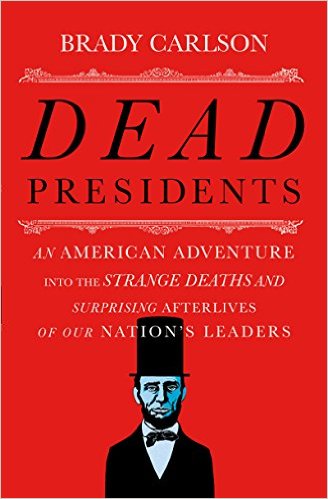Dead Presidents: An American Adventure into the Strange Deaths and Surprising Afterlives of Our Nation’s Leaders
- By Brady Carlson
- W.W. Norton & Company
- 336 pp.
- Reviewed by Lisa Kathleen Graddy
- March 29, 2016
A fun, fascinating look at how late commanders-in-chief continue to serve from the sweet hereafter

What is the job of a deceased commander-in-chief? That’s what Brady Carlson set out to discover in Dead Presidents: An American Adventure into the Strange Deaths and Surprising Afterlives of our Nation’s Leaders. Part biography, part travelogue, and part cultural commentary, the book is an examination of what he calls the “post-post-presidency,” in which our nation’s leaders may die but never really get to retire.
Starting at George Washington’s tomb at Mount Vernon and the Washington Monument, Carlson takes the reader on a tour of graves, collections, and memorials. It’s an enjoyable ramble that mixes tales of presidential deathbeds and ceremonious funerals and the drama that surrounds them.
We learn that Mary Lincoln threatened to take her husband’s body back to Washington if Springfield, Illinois, politicos buried him in any place other than the cemetery she had chosen. Contrary to the popular legend, although Thomas Jefferson and John Adams died just hours apart on the 50th anniversary of the Fourth of July, their last words were not about each other.
And James Garfield wouldn’t have died if his doctors had kept their fingers out of the bullet wound in his back — yet his chief physician had the temerity to bill the government $25,000 for his services. Congress didn’t pay.
Each new president is asked to create a funeral plan that is filed and updated for (hopefully much) later use. And when Americans get the chance, giving in to an impulse that is simultaneously a little bit sweet and a lot macabre, they can’t resist lifting a casket lid to see how well a presidential corpse is holding up or to prove that Zachary Taylor wasn’t poisoned in an anti-Abolition conspiracy.
What do we expect of these dead presidents in return for state funerals, a federal holiday every February, and any number of roads and schools named for them? A lot, according to Carlson. He believes our national leaders work considerable overtime: “The presidents keep on living long after they’re gone.”
That overtime started with our first president. The country ignored George Washington’s request for a private funeral with no public speeches or parades. We clung to “the indispensable man” in death and turned him into the honored exemplar of American values and patriotism and instituted a new American tradition of monuments and public mourning.
But how much work is there for a dead president in the 21st century? The cathartic public grief of Abraham Lincoln’s multi-city funeral train or John Kennedy’s state funeral are blessedly rare.
Modern presidential funerals spur as much reassessing of the departed as honoring, and we don’t automatically look to the presidents as role models now. Do we still need formal memorials when media keeps the president’s personal habits as well as his public pronouncements ubiquitous? Don’t former presidents shape their legacies through their libraries?
With wry humor, Carlson chronicles the changing fortunes of presidential tombs and reputations. Some of the elaborate 19th-century monuments and cemeteries have fewer visitors than they used to, but Americans still visit historic sites and learn about commanders-in-chief.
Grant’s tomb has been joined by a LBJ robot telling stories to visitors at the Lyndon Johnson Presidential Library and the national (Herbert) Hoover Ball Championship in Iowa. Presidential souvenirs are still plentiful. We approach the presidents, living and dead, with a bit less reverence and a bit more familiarity. We look to them less for their moral examples and more for their historical and cultural significance.
How we remember the presidents, Carlson says, reveals as much about us as it does about them. He ends by comparing the massive faces on Mount Rushmore, begun in 1927 to attract tourists to South Dakota, to the more accessible, if less awe-inspiring, life-size statues of the presidents that populate Rapid City, South Dakota, “the most patriotic city in America.” There is no room left for a president to be chiseled into the mountain, but the city can welcome 36 more statues. It looks like there is still a job for the dead presidents, just one on a more human scale.
Funny and thoughtful, Dead Presidents is like a road trip with a witty friend — the kind who tells stories that you want to pass along. The book is bound to be the jumping-off point for any number of lunchtime conversations. It will definitely be an excuse to trot out your best Groucho impression and ask a friend just who is buried in Grant’s tomb.
Lisa Kathleen Graddy is a curator of political history at the Smithsonian Institution’s National Museum of American History, where she spends a considerable amount of time contemplating dead presidents, first ladies, and other historic figures.

